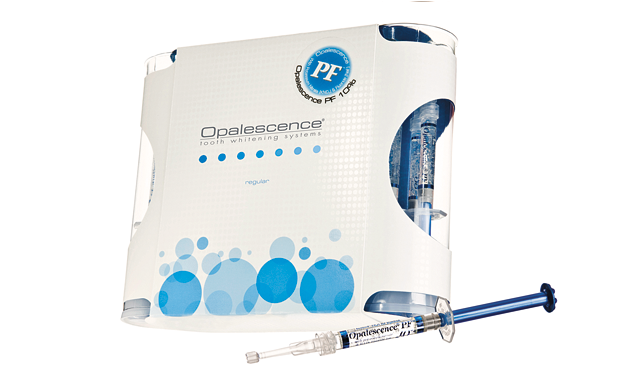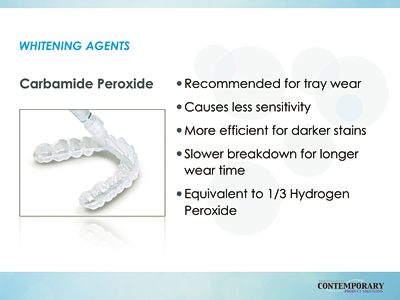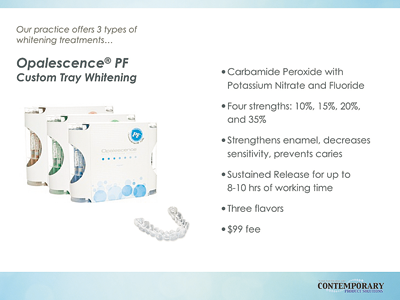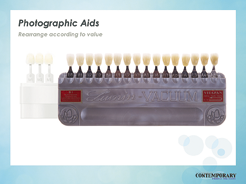How to use Opalescence for customized take-home whitening
An evaluation of Opalescence, a whitening system from Ultradent Products.

Although tooth whitening is establishing itself as a popular dental treatment, several factors must be considered when selecting the ideal whitening solution. The factors include patient lifestyle, tooth discoloration, compliance ability and tooth sensitivity.
With the ever-increasing patient demands for whitening options (increased comfort, convenience, effectiveness, etc.), dental manufacturers have created an array of whitening systems to meet these requests. As a result, dentists must determine the appropriate whitening solution that also matches the patient’s lifestyle and desired results, in combination with their clinical situation and overall oral health. With many factors to consider, selecting a whitening treatment can be challenging and overwhelming.
Introduced in the 1800s, in-office whitening was the primary choice for dentist-prescribed tooth whitening.1 However, the development of home-applied tray bleaching in the 1980s changed the field of tooth whitening dramatically.1 Unlike in-office treatments that require dental professionals to perform the procedure, at-home whitening is dentist dispensed and individually applied, significantly reducing the cost. With at-home whitening, patients are now able to whiten their teeth, following their dentist’s instructions, at their own convenience.
Trending article: How Opalescence Go can restore confidence in pediatric patients
Today, most dentists still offer these two types of whitening treatments, although with advancements in research the whitening materials have significantly evolved. In-office whitening uses a powerful bleaching agent (e.g. hydrogen peroxide, carbamide peroxide, sodium percarbonate peroxide) to effectively whiten teeth in a single office visit. While using the same potent bleaching material, at-home whitening contains a lower concentration of the active ingredient to whiten teeth.2 When supervised by a dentist, at-home or in-office peroxide bleaching has been shown to be safe and effective.3
Carbamide Peroxide is recommended for tray wear.

Another challenge in determining the appropriate whitening treatment plan is choosing the ideal whitening gel. Carbamide peroxide is the most common active ingredient in whitening materials, dissociating into hydrogen peroxide and urea.4 It is ideal for at-home whitening because of its slow breakdown during oxidation. Unlike hydrogen peroxide-which releases its whitening power almost instantly-carbamide peroxide releases about 50 percent of its whitening power in the first two hours and can remain active for up to eight hours.5
Therefore, the duration of exposure time and bleaching agent concentration directly affect the diffusion of hydrogen peroxide through the dentine and the efficacy of the whitening treatment.6,7 Thus, dental supervision is essential to ensure proper concentration and application time to avoid complications and side effects from whitening (gingival irritation, tooth sensitivity, minimal whitening results, etc.).
Continue to page two to learn about why professional supervision is key...
Why professional supervision matters
During the initial whitening consult, dentists should complete a thorough oral examination and evaluation with pre-operative photographs. With this information the dentist can monitor the tissues (hard and soft) throughout treatment to ensure the patient responds ideally to the whitening gel and no damaging effects occur, such as tooth demineralization or gingival irritation.
Opalescence PF is a flexible and customizable solution for your practice's whitening needs.

Opalescence PF is a flexible and customizable solution for your practice's whitening needs.After the initial assessment, determining the types of discolorations will help identify the appropriate whitening solution. With three classifications-intrinsic, extrinsic or internalized-tooth stains vary in their ease of removal. Extrinsic stains are localized on the tooth surface or within the pellicle layer by reaction between sugars and amino acids, or acquired from other external elements.8,9 Intrinsic stains, such as those from tetracycline or fluorosis, are found within the dentine, and result from systemic or pulpal origin.9 They are the most difficult type of stains to remove. Similarly, internalized stains are also located in the dentine, but result from extrinsic stains entering the dentine via tooth defects, such as cracks on the tooth surface.9
Although in-office treatment is ideal for a variety of tooth discolorations, darker stains (e.g. dark yellow and black teeth or stains from tetracycline and fluorosis) can be challenging to whiten, requiring more than one bleaching application.10 Used in conjunction with in-office treatment, at-home whitening can provide the ideal supplement to treat tougher stains.
At-home whitening is also effective as a standalone treatment and a practical alternative to in-office whitening. Effective at treating most discolorations, at-home whitening is still under dental supervision and monitoring. At-home whitening provides a cost-effective solution for those who can’t afford in-office treatment or for those who prefer the convenience of whitening at home. Dentist-dispensed at-home whitening minimizes risks involved in whitening such as uneven results, enamel damage or hypersensitivity, because the systems are supplied by dentists, who can diagnose any problems or special needs, plan the appropriate treatment and fabricate the customized tray used to apply the whitening gel.11
Trending article: A roundup of in-office whitening products
Challenges with at-home whitening
Photographic aids

While ideal for patients who desire to whiten their teeth on their own schedule, complications still occur with dentist-dispensed at-home whitening. Problems with patient compliance can arise due to discomfort and inconvenience. Poorly fitted trays can inhibit proper application of the whitening gel to the tooth surface, reducing the effectiveness of the hydrogen peroxide. Patients can have difficulty applying the material, especially if the gel is too thin. During whitening, some patients report discomfort as the tray moves or gel migrates out of the tray and onto gingival tissues. The discomfort can be exacerbated if the taste of the gel is unappealing.
Patients may also complain of increased sensitivity during and after whitening treatments. This side effect may be caused by changes of fluid in the dentinal tubules. Specifically, too much fluid moves out of the teeth during whitening, causing dehydration that leads to oral pain. Some whitening gels add water to their solution to ensure proper hydration. The addition of fluoride and potassium nitrate has also been shown to reduce tooth sensitivity.12-14 The application of fluoride also makes the teeth less susceptible to caries,15 and leads to fewer hazardous effects on the enamel mineral content.16
Further, as hydrogen peroxide degrades throughout the whitening process, it can create a more acidic environment that leads to potential tooth structure damage.17 Some whitening gels have an initial acidic pH, which can further favor demineralization of tooth enamel.18 Lower pH environments can lead to increased tooth sensitivity, gingival irritation, and bacteria growth. Adding buffers to the whitening gel ensures a basic or neutral pH.
Continue to page three for more...
The right solution for different patients
Ultradent Products has developed a system of at-home whitening treatments, Opalescence PF, that is cost-effective and reduces sensitivity and discomfort. Its unique formula allows for complete customization. With four different carbamide peroxide concentrations, dentists can tailor whitening treatments to an individual’s expectations, extent and type of tooth discoloration, and likelihood of compliance.
When determining the treatment plan for at-home whitening, dentists consider concentration, duration, application and desired results based on the patient’s type and extent of tooth discoloration. Opalescence PF is ideal for at-home treatments because of its versatility and customization depending on the patient’s desired results and clinical condition.
The whitening guide for the Opalescence whitening systems

Available in four carbamide peroxide concentrations (10, 15, 20 and 35 percent), Opalescence PF requires wear times ranging from 30 minutes to overnight. Opalescence PF is effective in removing discolorations due to congenital, systemic, pharmacologic and traumatic factors, as well as those resulting from fluorosis and tetracycline. The lower doses are suitable for patients who want to wear the whitening trays overnight or who demonstrate extra sensitive teeth. Higher concentrations are more appropriate for quicker results and those patients who have less availability to apply the whitening gel and wear the whitening tray. Dental professionals can therefore customize whitening treatments in terms of both concentration and duration to fit a patient’s schedule, lifestyle, and degree of tooth discoloration.
Trending article: The top things our dental experts are excited about in the coming year
In addition to versatility, Opalescence PF provides practical solutions to many of the common complications associated with whitening and at-home treatments. The safe and effective whitening gels include potassium nitrate and fluoride to reduce sensitivity and strengthen enamel. The gel also contains 20 percent water to prevent dehydration. Opalescence PF also contains buffers to maintain a neutral pH, thereby preventing an acidic environment and damage to the tooth structure.
Using a customized whitening tray, the Opalescence PF system promotes even application of the whitening gel and continuous contact between the gel and tooth structure throughout treatment. An easy syringe delivery improves the efficiency for loading the tray. The sticky, viscous formula helps keep the gel and tray in place, preventing the solution from migrating during treatment, thereby improving patient comfort, which helps patient compliance. Opalescence PF is also available in three flavors-mint, melon and regular-improving taste and comfort.
Trending article: The top 10 dental discoveries of 2016
Conclusion
With Opalescence PF, dentists can provide their patients with a proven whitening solution for at-home treatment. Effective in treating even the toughest of stains and discolored teeth, patients can complete the whitening treatments safely and efficiently following the dentist prescribed plan at their own convenience. The ideal tool to customize whitening treatments for all types of patients to fit their lifestyle, and with customized tray application and a thick, viscous gel, Opalescence PF is designed to reduce sensitivity, enhance comfort and improve patient compliance.
ACTIVA BioACTIVE Bulk Flow Marks Pulpdent’s First Major Product Release in 4 Years
December 12th 2024Next-generation bulk-fill dental restorative raises the standard of care for bulk-fill procedures by providing natural remineralization support, while also overcoming current bulk-fill limitations.